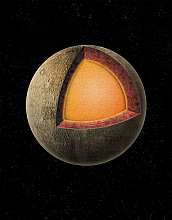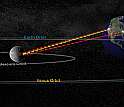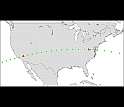|

Press Release 07-047
Mercury's Soft Center

Ground-based telescopes find strong evidence that Mercury has molten core
May 3, 2007
By tracking a subtle wobbling of the planet Mercury as it spins about its axis, researchers using a trio of ground-based telescopes have found strong evidence that the planet has a molten core.
In their paper, the researchers show that careful measurements of Mercury's spin--to an accuracy of one in 100,000--reveal that the planet's interior is decoupled from its exterior, providing strong evidence of a molten core.
Astronomer Jean-Luc Margot of Cornell University, Stan Peale of the University of California, Santa Barbara, Ray Jurgens and Martin Slade of the Jet Propulsion Laboratory (JPL) in Pasadena, Calif., and Igor Holin of the Space Research Institute in Russia report their findings in the cover story of the May 4, 2007, journal Science.
While most models for the formation of Mercury suggest the planet has an iron-rich core, many predict that the core is solid after billions of years of cooling. Others predict that small amounts of sulfur and other trace elements mixed with the iron have lowered the core's freezing point, keeping the planet's outer core from completely solidifying over that time.
While peering into the deepest interior of a planet--even our own--is difficult even with on-site technology, the ground-based telescope data collected by Margot and his colleagues provided evidence that strongly supports the latter scenario, suggesting the core is at least partially molten and may contain at least small amounts of sulfur.
The researchers used National Science Foundation's (NSF) Arecibo Observatory in Puerto Rico, part of NSF's National Astronomy and Ionosphere Center, NSF's Robert C. Byrd Green Bank Telescope in W. Va., and the NASA/JPL 70-meter antenna at Goldstone, Calif., to beam radar signals to the planet and then carefully analyze the echoes that returned.
To obtain their measurements, the astronomers compared the properties of the return signal as it struck the distributed telescope locations on Earth's surface. The amplitude of the wobbling was twice what the researchers expected for a solid planet, but on par with an object that has a solid exterior and liquid core.
The National Radio Astronomy Observatory is an NSF facility, operated under cooperative agreement by Associated Universities, Inc. The Arecibo Observatory is part of the National Astronomy and Ionosphere Center, which is operated by Cornell University under a cooperative agreement with the NSF. Part of this work was supported by JPL, operated by Caltech under contract with NASA.
Additional information will be available in the following press releases:
Cornell University: http://www.news.cornell.edu/stories/May07/margot.mercury.html
NSF's National Radio Astronomy Observatory : http://www.nrao.edu/pr/2007/mercury
-NSF-

Media Contacts
Joshua A. Chamot, NSF (703) 292-7730 jchamot@nsf.gov
Lauren Gold, Cornell University (607) 255-9736 LG34@cornell.edu
Blaine Friedlander, Cornell University (607) 254 8093 bpf2@cornell.edu
Dave Finley, NSF National Radio Astronomy Observatory (505) 835-7302 dfinley@nrao.edu
Program Contacts
Vernon L. Pankonin, NSF (703) 292-4902 vpankoni@nsf.gov
Principal Investigators
Jean-Luc Margot, Cornell University (607) 255-1810 jlm@astro.cornell.edu

The National Science Foundation (NSF) is an independent federal agency that supports fundamental research and education across all fields of science and engineering. In fiscal year (FY) 2009, its budget is $9.5 billion, which includes $3.0 billion provided through the American Recovery and Reinvestment Act. NSF funds reach all 50 states through grants to over 1,900 universities and institutions. Each year, NSF receives about 44,400 competitive requests for funding, and makes over 11,500 new funding awards. NSF also awards over $400 million in professional and service contracts yearly.
 Get News Updates by Email Get News Updates by Email
Useful NSF Web Sites:
NSF Home Page: http://www.nsf.gov
NSF News: http://www.nsf.gov/news/
For the News Media: http://www.nsf.gov/news/newsroom.jsp
Science and Engineering Statistics: http://www.nsf.gov/statistics/
Awards Searches: http://www.nsf.gov/awardsearch/
| 



